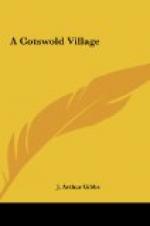Tom Peregrine is a great hand at catching water-voles in a landing-net. He holds the net over the hole which leads to the water, and pokes his stick into the bank above. The rat bolts out into the net and is immediately landed. House-rats—great black brutes—live in the banks of the stream as well as water-voles. They are very much larger and less fascinating than the voles. To see one of the latter species crossing the stream with a long piece of grass in his mouth is a very pretty sight They are rodents, and somewhat resemble squirrels.
[Illustration: In Bibury Village 358.png]
CHAPTER XV.
THE PROMISE OF MAY.
“Quis desiderio
sit pudor aut modus
Tam cari capitis?”
HORACE.
About the middle of May the lovely, sweet-scenting lilac comes into bloom. It brightens up the old, time-worn barns, and relieves the monotony of grey stone walls and mossy roofs in the Cotswold village.
The prevailing colour of the Cotswold landscape may be said to be that of gold. The richest gold is that of the flaming marsh-marigolds in the water meadows during May; goldilocks and buttercups of all kinds are golden too, but of a slightly different and paler hue. Yellow charlock, beautiful to look upon, but hated by the farmers, takes possession of the wheat “grounds” in May, and holds the fields against all comers throughout the summer. In some parts it clothes the whole landscape like a sheet of saffron. Primroses and cowslips are of course paler still. The ubiquitous dandelion is likewise golden; then we have birdsfoot trefoil, ragwort, agrimony, silver-weed, celandine, tormentil, yellow iris, St. John’s wort, and a host of other flowers of the same hue. In autumn comes the golden corn; and later on in mid winter we have pale jessamine and lichen thriving on the cottage walls. So throughout the year the Cotswolds are never without this colour of saffron or gold. Only the pockets of the natives lack it, I regret to say.
Every cottager takes a pride in his garden, for the flower shows which are held every year result in keen competition. A prize is always given for the prettiest garden among all the cottagers. This is an excellent plan; it brightens and beautifies the village street for eight months in the year. In May the rich brown and gold of the gillyflower is seen on every side, and their fragrance is wafted far and wide by every breeze that blows.
Then there is a very pretty plant that covers some of the cottage walls at this time of year. It is the wistaria; in the distance you might take it for lilac, for the colours are almost identical.
Then come the roses—the beautiful June roses—the nimium breves flores of Horace. But the roses of the Cotswolds are not so short lived for all that Horace has sung: you may see them in the cottage gardens from the end of May until Christmas.




